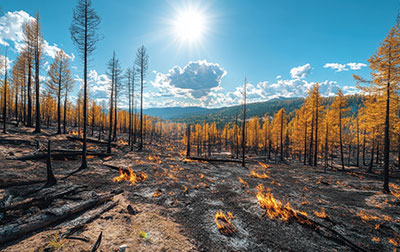Rethinking the road ahead: How to adapt to climate change

Today, we find ourselves at a crossroads in what had long been a straight path where making the wrong choice could steer us dangerously off course. Climate-driven challenges are prompting revisions and adjustments in many regulatory and non-regulatory areas, including societal, scientific, and engineering practices. Reliance on fundamental scientific evidence, increased public awareness, changes in how we design and build, and adjustments in resource allocation are all issues that affect actions toward climate change.
Engineers have long relied on physical principles and standards shaped by decades of experience. However, we are currently at the stage where regulation through standards and codes is largely lagging behind scientific advancements concerning the causes and consequences of climate change.
Since the 19th century, our ability to model and quantify climate change has advanced dramatically. The Intergovernmental Panel on Climate Change (IPCC) remains the most authoritative source on climate science, impacts, and response strategies. Its periodic Assessment Reports (ARs) synthesize global climate data and modeling to inform policy and action.
The IPCC provided a scientific basis to the Paris Agreement in 2015 with signatories from 194 countries and the European Union representing virtually all countries in the world. The central aim of the Agreement was to strengthen the global response to climate change. It set a goal to limit global temperature to no more than 2°C above pre-industrial levels, with efforts to keep it to below 1.5°C.
The most recent IPCC Sixth Assessment Report (AR6) was finalized in 2023. It includes potential future scenarios used to represent quantified projections of possible climate conditions based on multiple factors, including greenhouse gas (GHG) emissions.
Alarmingly, 2024 was the hottest year on record, pushing us closer to—and in some cases beyond—the 1.5°C threshold. This makes the most optimistic scenarios increasingly unlikely. As a result, the global focus must shift. While reducing GHG emissions remains essential, adaptation is becoming equally critical.
The pathway that society will choose is uncertain. The longer it stays on a mostly business-as-usual course, the more climate-related efforts will inevitably shift toward adaptation as opposed to the implementation of the preventive mitigation measures. Besides putting a strong emphasis on GHG emissions reduction, carbon capture efforts, and other technological advances, we should prioritize more precise quantifications of future climate conditions with a focus on implementing adaptation options at an increasing scale.
Currently, Canada’s national building, electrical, fire, and energy codes are being updated to reflect changing climate data rather than relying solely on historical trends. Examples of the new updates are long-term average patterns of temperature and precipitation, climatic extremes, the six hottest hours in July, the largest amount of rain in a 15-minute period, and the maximum wind gust a structure can safely withstand.
Many countries, provinces, cities, municipalities, utilities, infrastructure organizations, and business organizations have begun to develop initial climate adaptation plans (CAPs) and conduct climate risk assessments. However, many other organizations have yet to establish actionable CAPs with set goals. Climate adaptation must be tailored to each organization’s unique risks, assets, and constraints. Many jurisdictions currently require public companies to regularly disclose their climate-related risks, and a growing number of private companies are following suit.
The climate vulnerability assessment and adaptation process usually progresses through several stages:
- Scoping: This initial phase includes identifying the geographical location, assessing the nature and condition of physical assets, reviewing historical climate data and past experiences, and selecting relevant climate scenarios and hazard projections.
- Risk identification: Climate risks are identified by evaluating the exposure of assets to climate hazards and assessing their vulnerability.
- Risk analysis and evaluation: This stage involves analyzing the likelihood and potential consequences of identified risks, followed by prioritizing them for treatment.
- Mitigation planning and implementation: The results of the risk evaluation inform the development and implementation of appropriate mitigation measures.
The effects of climate change are already visible. As our world becomes warmer, the severity of these effects will continue to escalate at an unprecedented rate. It is imperative that we act to both mitigate and adapt to its effects.
Companies across all sectors are setting targets to reduce their GHG emissions, developing CAPs, and executing decarbonization and resilience projects. Fortunately, they don’t have to do it alone.
Hatch brings extensive experience in supporting global clients with climate-related initiatives, having contributed to multiple projects across the metals, energy, and infrastructure sectors. From early-stage assessments and feasibility studies to full-scale implementation, we deliver practical, results-driven solutions. Whether you are developing a company-wide decarbonization strategy or detailed site-specific action plans, we provide the technical insight and hands-on support needed to turn goals into reality. Contact us to learn about our climate change solutions.
